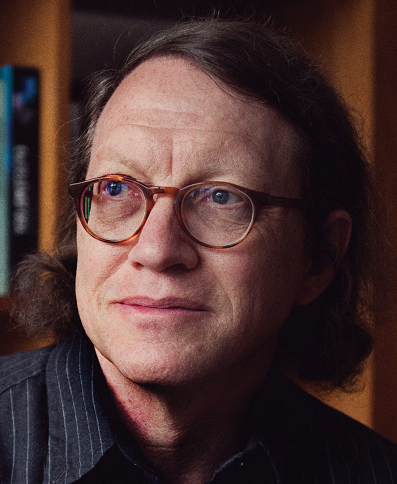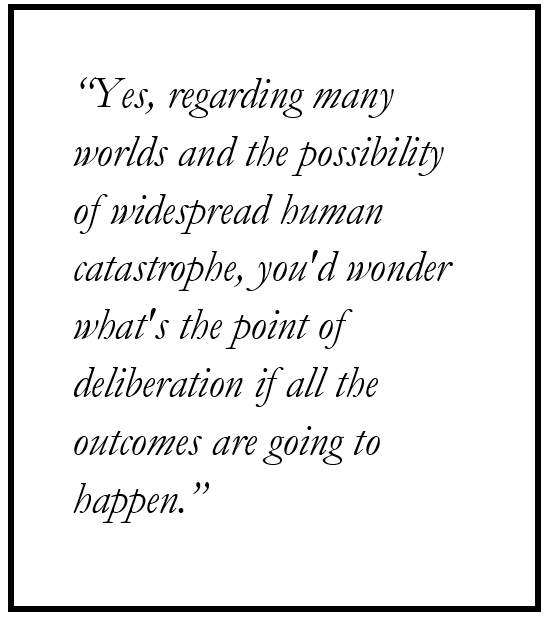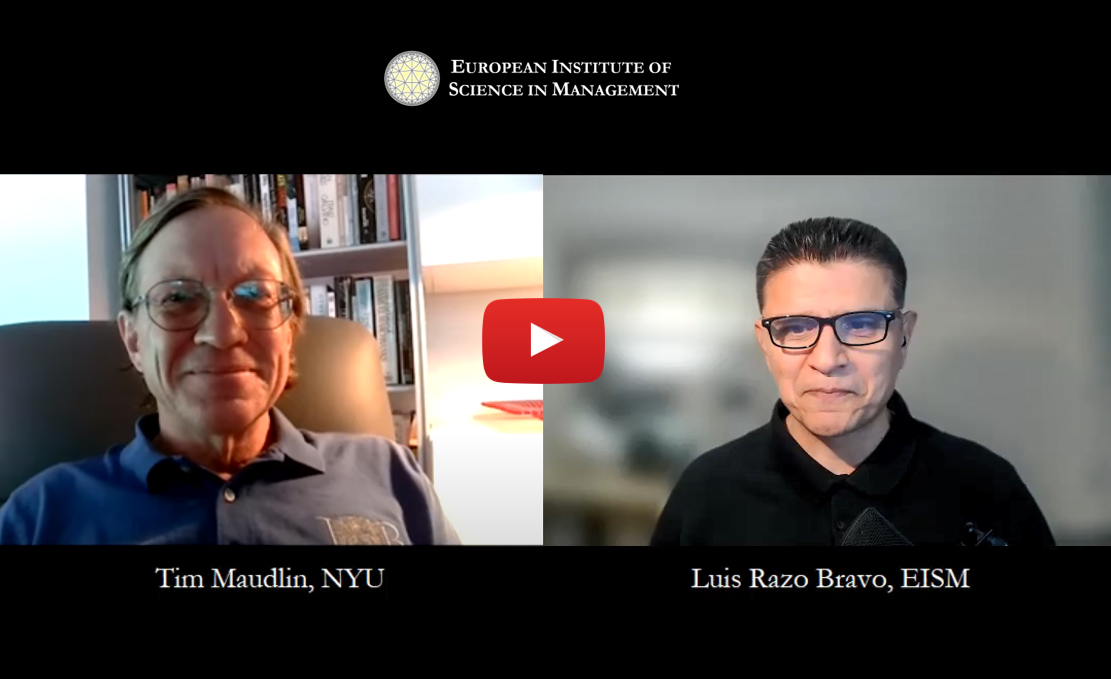
Dr. Tim Maudlin is an internationally-renowned philosopher of science and philosophy professor currently associated with New York University. He is known for the clarity of his thought, above all in the foundations of physics, which is the subject of today’s discussion. Maudlin has undergraduate degrees in physics and philosophy from Yale University and a PhD from the Univ. of Pittsburgh. His books, released by the world’s most respected publishing houses, include Quantum Non-Locality and Relativity, Truth and Paradox, The Metaphysics Within Physics, and two volumes of Philosophy of Physics. In addition, his New Foundations for Physical Geometry has received wide acclaim as a novel mathematical approach to a deeper understanding of space-time.
Prof. Maudlin is a member of the International Academy of the Philosophy of the Sciences and the Foundational Questions Institute (FQXi). He has been a Guggenheim Fellow, taught at Rutgers for many years and has been a visiting lecturer at Harvard. He is also founder and director of the John Bell Institute for the Foundation of Physics.
* The following text has been slightly edited and excerpted from the full interview, which may be viewed here or by clicking on the video thumbnail image below.

Can you contextualize the historical significance of this year’s Nobel prize in physics, especially against the backdrop of non-locality?
Sure, I’d be glad to do that because the story, the narrative about this prize really goes back all the way to the beginnings of the development of what was called the new quantum mechanics in the 20’s. There’s the old quantum theory developed by Bohr, was just one that said electrons and atoms can go in certain orbits but nothing between them. So they’re kind of jumping, all they can do is jump between these orbits – and that was associated with noticing that certain energies were always showing up. But Bohr didn’t have any theory about how that happened or why things would be constrained. It was just a bit of numerics. And then, in the middle of the 20’s, first Heisenberg and then Schrodinger, developed much more detailed theories using different mathematics, which formed the basis and the foundation of what we now call quantum theory. And one thing that happened was Bohr and the so-called Copenhagen School took a very strong view about what had been accomplished. Essentially, Bohr said “we’ve reached the ends of physics. This is a kind of final theory. There’s nothing more that anybody could learn. There’s nothing more that anybody could say. There’s nothing more than anybody could understand about physics than to manipulate this mathematical formalism in accordance with these rules”. And Einstein was having none of it from the beginning. Not only did he not like the idea that there couldn’t be no further progress here. The Copenhagen understanding had certain features which he specifically disliked. And these are actually linked together. Everybody is probably familiar with Einstein saying things like “God does not play dice with the universe”, which was his objection to the idea that, fundamentally, things happen with no reason at all about why they happen one way rather than another, so they just happen at random, maybe with a certain probability.
And then the other thing he said and that that everybody probably has heard is that he didn’t like so-called spooky action at a distance, which he identified as one of the features of this standard interpretation. And they’re connected because if something random happens here, okay, maybe that happens, but it’s not merely that something random would happen here but in virtue of it happening that physically things would change everywhere, and this was the so-called collapse of the wave function. So if a spot forms on a screen somewhere, I can say, well gee is there some reason it formed there rather than somewhere else? You might have thought that yeah because there was a particle headed toward the screen that hit it there. And Bohr and company would say no, no, no, that’s not right. Really, there was some chance that that spot formed anywhere on this screen. And then Einstein said, but wait a minute, so when a spot forms here you’re then telling me that instantaneously there’s no longer any chance that one will form anywhere else. And that that’s a physical change, right? A moment ago, there was a chance and now there isn’t. And he objected to that, so he raised those objections already back in the middle 20s using examples with just a single particle, like hitting a screen. And then in 1935 he and Podolsky and Rosen wrote a famous paper where he expanded that to cases where you have a pair of particles that are created in a certain kind of quantum mechanical state such that doing an observation on one of them allows you to make a perfect prediction about how the other one will behave. And even though the initial state does not determine how either of them will behave, it does determine that their behaviors will be related to each other…
So Einstein objected to this as spooky action at a distance and um he wrote that paper in 1935. It had a very deep impression on Schrodinger. Bohr tried to respond to the paper but in a way no one can really quite understand what he’s claiming and it sort of stayed that way um for decades until John Bell came along.

Ok, that brings us up to John Bell. What is Bell’s inequality?
Bell’s inequality basically says if you have a local theory of any kind, the correlations you would see in these widely separated laboratories are restricted by a certain number – and it turns out less than or equal to two for one particular number – and quantum theory predicts, no, you’ll see stronger correlations. And so, if that were true, if the quantum mechanical prediction were correct, what Bell would have proven is that you should give up looking for a local theory because no local theory can reproduce these phenomena. And this is not particularly about quantum mechanics. I mean you could throw away quantum mechanics. It doesn’t matter. If you go into the lab and you see these correlations between these two sides, no local physics will be able to explain that. And that was what Bell proved and then that set the table for the experimentalists to go check.
What role did Clauser, Aspect, and Zellinger play in this development?
Unfortunately, you know, Bell died unexpectedly and rather young, so if he had been alive, of course, he would have gotten the Nobel Prize for the theoretical work. But he’s not and the prize was finally given to John Clauser, who did kind of the first lab experiments checking this, and Alain Aspect, who then made the experiments more sophisticated in certain ways and Anton Zeilinger who then made them even better um there have been improvements in detector efficiency and the distance between these labs and so on so there’s been a steady stream of making these experiments cleaner and cleaner but the main point is that they consistently show what quantum mechanics predicts namely that you’ll violate Bell’s inequality and if that’s true then you should just give up on locality because you can’t have a local theory that’ll predict that.

Can you explain the common misconceptions regarding the work of Clauser, Aspect, and Zeilinger that even the Nobel Prize committee has fallen prey to?
Yes, so the irony is, what many people have said, even what is reported by the Nobel committee that gave the prize, is that what these experiments ruled out was not locality, it was something called hidden variables. And the idea of hidden variables, this goes back to what I talked about with Bohr before. Bohr said this quantum mechanical description, a mathematical description, a thing we call a wave function, tells you all there is to know about a system. Two systems described by the same wave function are physically identical in all respects. And Einstein said, “Why should I believe that? Maybe there’s more to the system than is represented in the wave function.” And that’s what the EPR paper was all about, it was basically saying, to save locality, you better accept that quantum mechanics is incomplete.
And any theory that postulates more to a physical system than is represented in the wave function has gotten the bad name “a hidden variables theory”. Now Bohm’s theory, or Bohmian mechanics, or the pilot wave theory that that Bell read about is a hidden variables theory. And then people report that what these experiments did was they ruled out hidden variables theories, which is just nonsense because it was a hidden variables theory that Bell realized made this prediction. So the experiments didn’t rule it out, at all, and in fact Bell was a big supporter of this pilot wave theory. He wrote a very beautiful article called “On the Impossible Pilot Wave”, telling physicists to pay attention to this theory. And then the Nobel Prize committee says oh these experiments showed that the theory is wrong. No, not at all. Not in the least.
Can one object that the “many worlds” interpretation of quantum mechanics says absolutely nothing about averting the possibility of extinction?
Yes, one might well worry that if you thought all the outcomes are going to happen no matter, why am I deliberating. You’d wonder what’s the point of deliberation if all the outcomes are going to happen.



